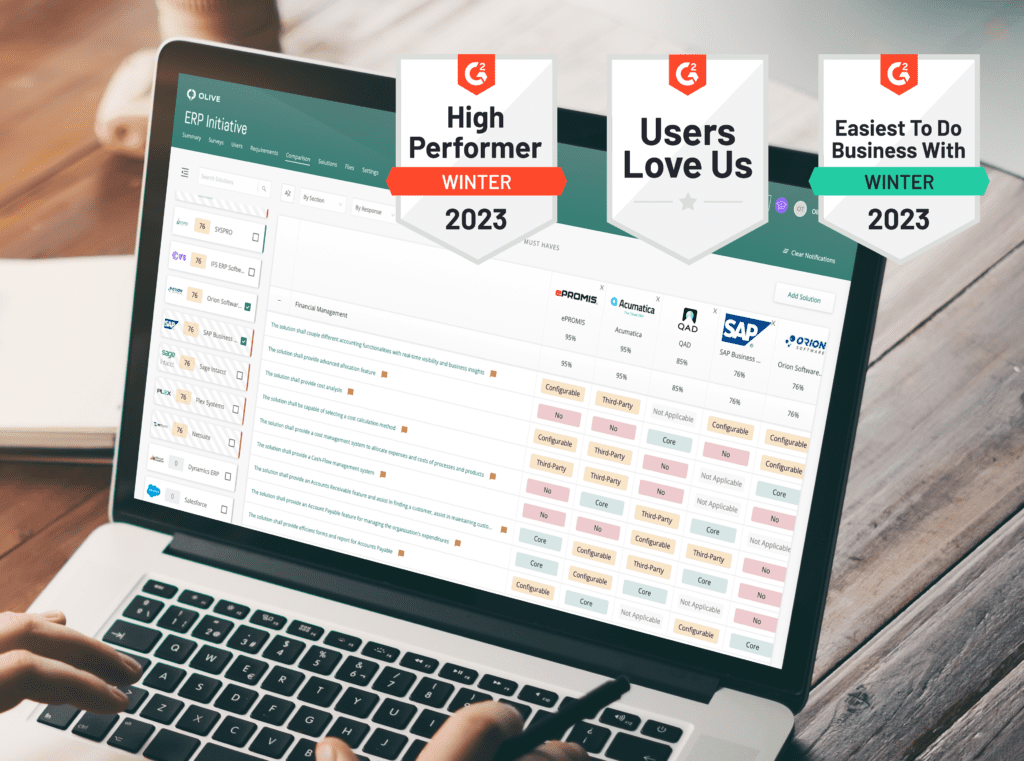Removing Bias from Your Software Selection Process for Optimal Vendor Choice
Digital transformation has brought about numerous software solutions that can simplify our lives and enhance work processes. However, the high rates of software project failure, abandonment, and overrun indicate the need to address common mistakes resulting from cognitive biases. This article aims to define and outline cognitive biases that impact software evaluation projects, providing guidance on how to avoid them for selecting the best software vendors for your business.
Avoid these 10 Cognitive Biases when Selecting Enterprise Software;
1. Anchoring bias
Anchoring bias happens when pre-existing information or the first thing you find influences your decision-making.
Let’s say, for example, you are looking into a new ERP system for your organization. You see one for what appears to be a reasonable price and a second one for half the cost. You might assume that the second option is ‘better’ based on the first price you saw, despite maybe the less expensive option being an ideal match for your company’s requirements. The first price you saw influenced your decision.
Avoid falling into this bias by thoroughly evaluating each software option based on its merits and compatibility with your organization’s requirements, rather than relying solely on the initial information, incentivized reviews or pricing.
2. Availability Heuristic
The availability heuristic leads to the confusion of “easy” with “true.” Overcome this bias by avoiding hasty generalizations based on past experiences with a particular company or software. Instead, focus on the specific context of your organization’s needs and the potential fit of the software being evaluated.
“That software probably won’t work for us because last time we used that company, the project failed.
3. Blind-spot Bias
The blind-spot bias means recognizing the impact of biases on others’ judgments while failing to see the effects of biases on one’s own judgments.
Jill thinks that software won’t work for us because last time we used that company, the project failed, but I have worked with Jack successfully before, and I know they will nail the project!
4. Choice-supportive Bias
Choice-supportive bias occurs when the chosen option is favored, despite its flaws. To mitigate this bias, critically evaluate each option’s strengths and weaknesses, making an objective assessment that goes beyond personal attachment or confirmation of the choice already made.
For example, if you choose CMS option A instead of CMS option B, you will likely ignore or downplay option A’s faults while amplifying or subscribing new negative flaws to option B.
5. Clustering Illusion
The clustering illusion is the tendency to see random patterns in random events, as non-random.
Often with software evaluation projects and processes, there are so few data points that patterns cannot exist.
The clustering illusion involves perceiving non-random patterns in random events. Recognize that with limited data points in software evaluation, patterns may not exist, and decisions should be based on thorough analysis rather than perceived patterns.
6. Confirmation Bias
Confirmation bias occurs when one selectively seeks and interprets information that supports pre-existing beliefs. Counteract this bias by actively seeking out diverse perspectives, thoroughly researching vendor case studies, and considering both the positive and negative aspects of each option.
I read the vendor’s case study for a successful project with another company, and I firmly believe that this vendor will be perfect for our project.
7. Conservatism bias
Conservatism bias refers to insufficiently revising beliefs in the face of new evidence, favoring older evidence. Avoid this bias by objectively reassessing previous experiences and considering the specific requirements and context of your current software evaluation process.
Consider a scenario where a company had a negative experience with an enterprise software system several years ago. The software failed to meet their specific requirements, resulting in wasted time and resources. As a result, the company decided not to renew the contract when it expired.
Fast forward to the present, and the company is in need of a new enterprise software system for a different department or project. Despite the significant time gap and the fact that the requirements and circumstances have changed, the decision-makers still hold a strong belief based on their past negative experience.
Due to conservatism bias, the decision-makers are hesitant to revise their beliefs and give the same vendor or similar software systems another chance. They might favor old evidence (the past negative experience) over new evidence (current features, functionalities, and vendor improvements).
In this case, the conservatism bias prevents the decision-makers from objectively assessing the suitability of the vendor’s updated software offerings for their current needs. They may miss out on potential solutions that have significantly improved or evolved since their previous experience, resulting in a suboptimal choice or missed opportunities for innovation and efficiency.
Nobody got fired for buying IBM
This saying, often attributed to the technology industry, is commonly known as “Nobody got fired for buying IBM.” It originated in the mid-20th century when IBM was a dominant force in the computer industry. The phrase highlights the perceived safety and reliability of choosing established and well-known vendors, like IBM, for software or technology purchases.
The saying implies that decision-makers may feel more secure and less vulnerable to criticism or repercussions when they opt for a reputable and established vendor, even if newer or more innovative alternatives are available. The familiarity and track record of companies like IBM was considered a safe choice, minimizing the risk associated with decision-making in technology procurement.
While the saying specifically mentions IBM, it has been adapted over time to reflect other industry leaders or prominent brands. It illustrates the tendency to prioritize reliability and minimize personal risk over potential benefits that may come from selecting lesser-known or emerging vendors.
8. Information bias
Information bias arises from inaccurate measurement, collection, or interpretation of critical information. Ensure that all stakeholders’ needs are accurately captured, allowing for comprehensive and reliable data that can inform the decision-making process.
9. Ostrich effect
The ostrich effect involves ignoring negative or critical information that should be considered. Acknowledge and address potential risks, listen to all departments’ input, and avoid disregarding their recommendations solely based on cost concerns or short-term convenience.
For example – when people ignore the needs of IT departments because it is just seen as a cost center. IT often highlights potential risks and necessary upgrades but is often ignored because “if it ain’t broke, don’t fix it”.
Until it breaks, and then it’s a massive scramble to get things fixed. They are also often ignored during evaluations until the last mile.
10 Bandwagon effect
Did you make sourdough during the COVID-19 Lockdown? If so, you may have succumbed to the bandwagon effect. This is a phenomenon in which people do something because they see others doing it. In software evaluation, this may show up as buying whatever your competitors are using, even if it’s not the right product for your business.
The bandwagon effect leads to following others’ choices without proper evaluation. Instead of blindly following competitors or industry trends, focus on your organization’s unique requirements and thoroughly evaluate software vendors based on their suitability for your specific needs.
Avoid these biases when Selecting Software Vendors
Eliminating cognitive biases is essential for selecting the best software vendors for your business. By being aware of these biases and consciously avoiding them, you can make more informed and objective decisions. Consider utilizing Olive, an unbiased technology sourcing platform, to simplify the software evaluation process and receive accurate evaluations tailored to your organization’s needs. With a commitment to unbiased decision-making, Olive empowers you to choose the software that best aligns with your requirements and maximizes value for your business. Olive is efficient and free of bias, revolutionizing the process of sourcing technology and delivers the value you would get from an IT consultant.
Everything we do here at Olive is without bias. We make decisions based on facts, not opinions, and pass this down to our customers. We are the only software evaluation platform that does not charge our vendors.
Acknowledgments
Part of the information in this article comes from;
Kent Hendricks The availability heuristic: Why your brain confuses “easy” with “true”
Samantha Lee, Drake Baer 20 cognitive biases that screw up your decisions
Daniil Pavliuchkov Fixing your blind spot: biases in decision making





